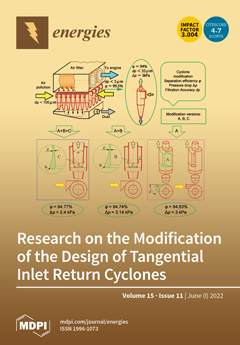This paper studies the effects of different exhaust gas recirculation (EGR) rates (0%, 5%, 10%, and 15%) on the combustion, performance, and emission characteristics of a biodiesel–diesel (20% biodiesel + 80% diesel) blended fuel engine. This paper mainly analyzes the effects on engine
[...] Read more.
This paper studies the effects of different exhaust gas recirculation (EGR) rates (0%, 5%, 10%, and 15%) on the combustion, performance, and emission characteristics of a biodiesel–diesel (20% biodiesel + 80% diesel) blended fuel engine. This paper mainly analyzes the effects on engine cylinder temperature, cylinder pressure, brake thermal efficiency (BTE), brake-specific fuel consumption (BSFC), NO
x emissions, carbon monoxide (CO) emissions, hydrocarbon (HC) emissions, and soot emissions. Firstly, a 3D-CFD model was established by using CONVERGE software, combined with an improved chemical kinetic mechanism including 98 species and 314 reactions, and the accuracy of the simulation model was verified by experimental results. Secondly, the effects of different EGR rates on the combustion, performance, and emission characteristics of biodiesel–diesel blended fuel were studied. The results showed that with the increase in the EGR rate, the cylinder pressure and cylinder temperature in the cylinder decreased. When the EGR rate was 15%, the maximum cylinder temperature decreased by 4.33%. In addition, BSFC increased and BTE decreased. Moreover, with the increase in the EGR rate, NO
x decreased significantly, and the higher the EGR rate, the more obvious the reduction in NO
x emissions. When the EGR rate was 15%, NO
x was reduced by 78.89%. However, with the increase in the EGR rate, the emissions of soot, HC, and CO increased. The optimal EGR rate for the engine is 10%.
Full article





